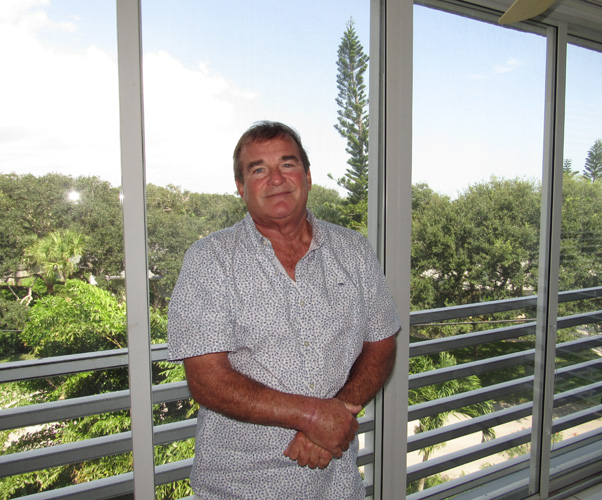
“I’m still having nightmares. Every time I close my eyes, I hear the roar,” says Bobby Childs, who experienced Hurricane Dorian’s wrath first-hand. “But people were awesome; they were all so loving and helpful. I saw the best in people and I saw the worst in people.”
Childs and wife Elizabeth (Liz) are among the lucky ones. He survived and they own a condo in Vero’s South Beach area, where they can regroup. It will be a while, however, before they’ll know the full extent of the damage to what was once their lovely waterfront home on Lubbers Quarters Cay, a tiny 2-mile-by-half-mile island in the Abacos, accessible only by boat. Or for that matter, the boat and car they stored in nearby marinas.
When Dorian became a named storm, Childs, who after selling his collision repair businesses became a yacht delivery skipper, went down to shore up the house. Liz, a representative for Pantaenius Yacht Insurance, was at a Newport boat show, so first mate/chef Karen Svea Grahne volunteered to assist him. Childs was still recovering from a mid-August wrist operation to correct a decades-old navicular fracture.
Once in the Abacos, he emailed Chris Parker, chief forecaster of the Marine Weather Center, who expected that while the storm might not have the same intensity as Hurricane Floyd, which caused heavy damage to the Bahamas in 1999, it would stop and hover for many hours and the destructiveness could be a lot worse.
“And that’s when I knew it was going to be really bad,” says Childs. They began intensifying preparations for the house and guest cottage, both built on reinforced concrete pilings to a height of 10 feet.
“When the storm came on, it was high tide when the worst of it hit. It just hit with such intensity; I’ve never seen or heard anything like it,” says Childs.
When shutters began to pull loose, and flying debris shattered windows and furnishings, they nailed up plywood – and it held. He is told winds at that point were clocking at about 185 miles per hour.
“It was terrifying,” says Childs. “And then, all of a sudden, the wind continued to intensify and I just felt the house moving. It buckled and the pilings started coming up through the floor. I was thinking at that point we were going to die.”
Substandard materials had evidently been used for the pilings, causing the main house to collapse onto the ground; the guest cottage was on its side.
During a brief lull, they began searching for a safer place, but found houses that were either destroyed or were shuttered and couldn’t be accessed.
A local Bahamian, whose roof was half off, invited them into a lower room of his house, where they spent the next 48 hours.
“It never stopped raining for the next three or four days. The roof leaked like crazy and we were constantly soaking wet.”
With boats destroyed and no phone service, the nine people left on the island’s southern end went into survival mode, searching house to house for generators, gas, canned goods and water, all while dealing with insects, wet feet, broken glass and the elements.
They eventually found a dry room and made an emergency helicopter landing strip, but then began hearing stories on VHS radios about armed looting on other islands. “It was pretty terrifying; we had no way to defend ourselves.”
His wrist now swollen and infected, he became feverish. Grahne and a neighbor were able to contact the Coast Guard and, while the helicopter he was evacuated on was already packed, they returned to rescue the others.
Eventually making it to a private Nassau airport, he received some treatment and was finally able to contact Liz, who booked him a hotel room and a flight out. “I don’t know how she did it.”
Unfortunately, he says, the Bahamian government is seemingly overwhelmed by the catastrophic devastation, and the road to recovery will be a long one.
“There were people who didn’t have food or medication for three or four days; their houses and everything in them was gone,” he says, including passports and visas. “It’s horrifying; our island is just destroyed, uninhabitable. Poor fishing communities are destroyed. It’s heartbreaking. I don’t know how they’re going to get the infrastructure going again.”
His main concern now is where the Bahamian people, whose homes and livelihoods have now vanished, will go next.
“Oh man, these poor people,” he says, his voice choked with emotion. “Everything’s gone.”



